The First Japanese Kitchen Knife with Some Western Toughness
This is the knife that brought Japanese cutlery into western kitchens. It was also one of the best arguments that stamped blades aren’t worse than forged blades by default. The G-2 was groundbreaking in the 80’s, and it still holds its own pretty well today, although it remains unique enough to stand out.
In that sense, it feels a little pointless to write a review on this knife over thirty years after its release. It’s good, and you should know that by now.
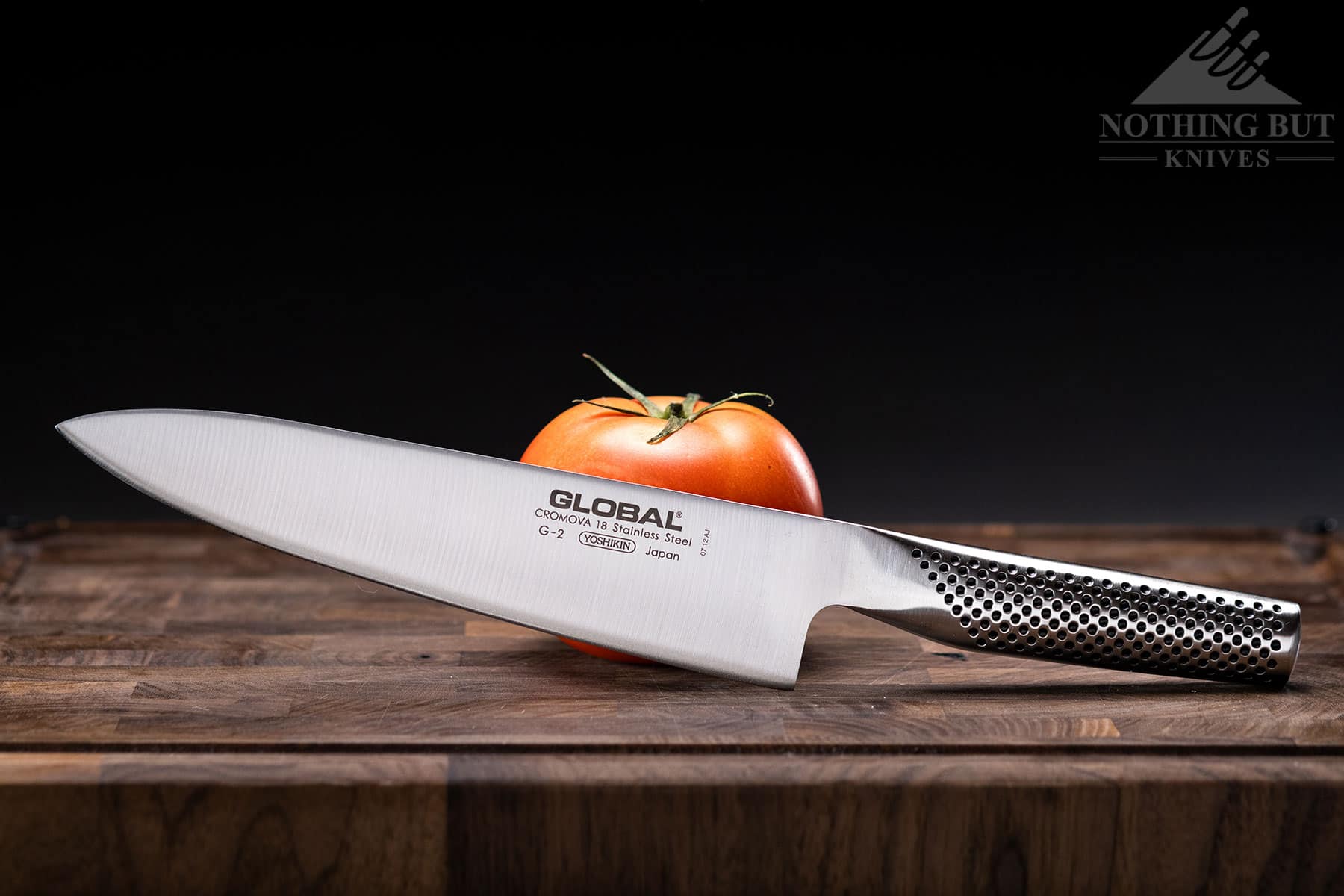
But maybe you don’t, and maybe there’s a bunch of idiots out there saying it’s good or bad without giving any real attention to what specifically is good or bad about it, so here I am trying to be specific in between a bunch of pretty pictures.
Specifications
| Overall Length: | 13.0” |
| Blade Length: | 7.9” |
| Blade Steel: | Cromova 18 |
| Hardness: | 56 – 58 HRc |
| Blade Thickness: | 2 mm |
| Blade Shape: | Gyuto chef’s knife |
| Blade Grind: | Convex |
| Handle Length: | 5.0” |
| Handle Material: | Steel |
| Weight: | 172 g |
| Made in: | Japan |
Pros
| Super lightweight and well balanced |
| Tougher than your average Japanese knife |
| Fairly good food separation |
| Good performance at a near budget price |
Cons
| Difficult to sharpen properly |
| The all-steel look isn’t for everyone |
| Steel handles can be slippery |
| Handles are a blister risk for some people |
The Blade
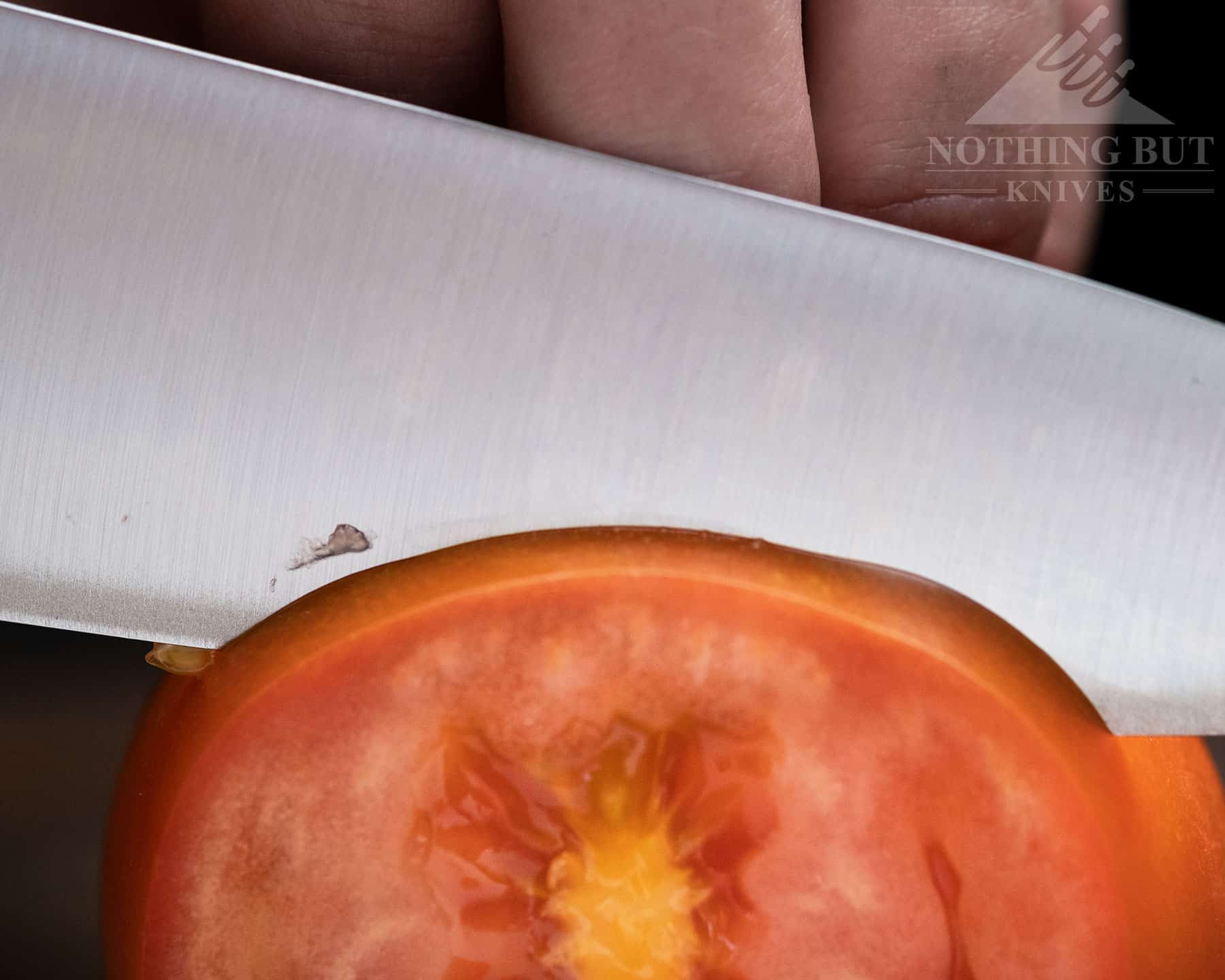
I’ve used knives that are technically thinner, either at the spine or behind that edge, that don’t feel as nice as the G-2.
With your typical super thin Japanese gyuto, you get a really aggressive bite that can slam through a tomato. The G-2 gives a little more resistance. Not so much that the cut feels sluggish, but just enough that I feel like I have more control over the cut.
This makes it really nice to cut harder, root-like vegetables like carrots because it separates the pieces more gently. Sometimes I don’t even realize when I’ve finished a cut on a tomato slice because I don’t always feel that final point of separation.
This gets into some blade geometry minutiae that I won’t claim to have a full grasp on (but I’m going to talk about later anyway), but the short version is that the G-2 has a convex grind with no microbevels. It’s like a thinner version of the grind on the production Mattia Borrani.
Edge Retention
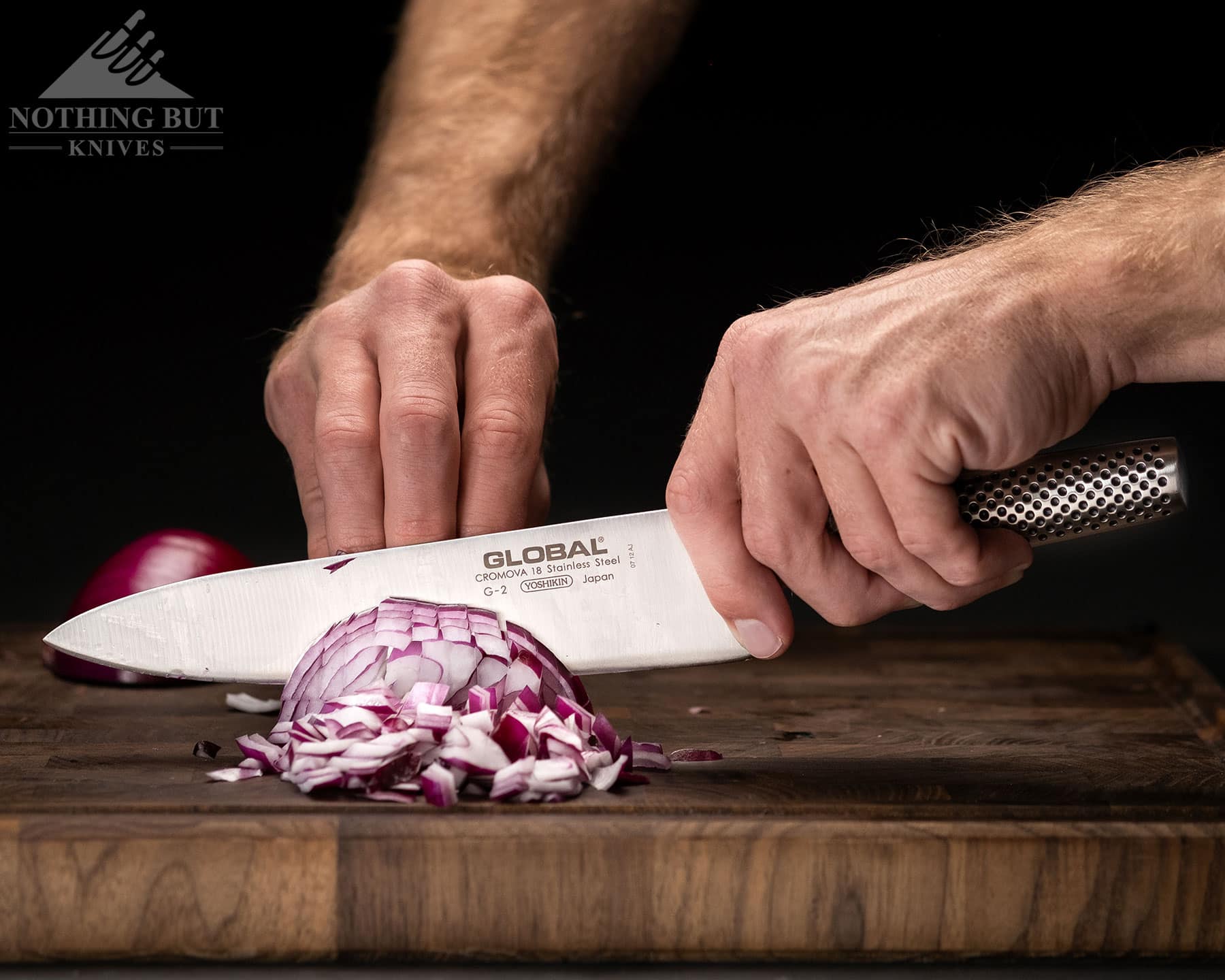
So it has a nice, thin cutting edge, but one of the issues of convex grinds is that the thin grind disappears very quickly. This ends up being pretty thick behind the edge for starting at around 12°. The other side of that is that convex grinds don’t really wedge the way flat grinds do. This tends to separate more than wedge into foods, which I enjoy quite a bit.
The problem is that between the thickening grind and the weird, soft steel, the edge retention isn’t exactly stellar. I’d put it above a Zwilling Pro edge for retention, but it’s definitely below the more popular Gyutos out there.
The catch is that most people probably won’t notice that change in the edge for a while. I tested this knife for about a month, and used it heavily for about a week. There was definitely a change in cutting paper after that, and I noticed some little rolls and imperfections along the edge that I managed to mostly take care of on a strop. But I didn’t notice a huge change in performance when I was using the G-2 in the kitchen.
Now, I rarely cook for more than two people, but if you get this thing fresh out of the box, and you’re using it for regular home cooking, you should probably strop it at least once a month and sharpen it once a year.
This becomes a more complicated knife if you plan on using it on the job, because edge maintenance is just trickier than usual, both because of the convex grind and the steel.
Global’s Steel and Edge Geometry
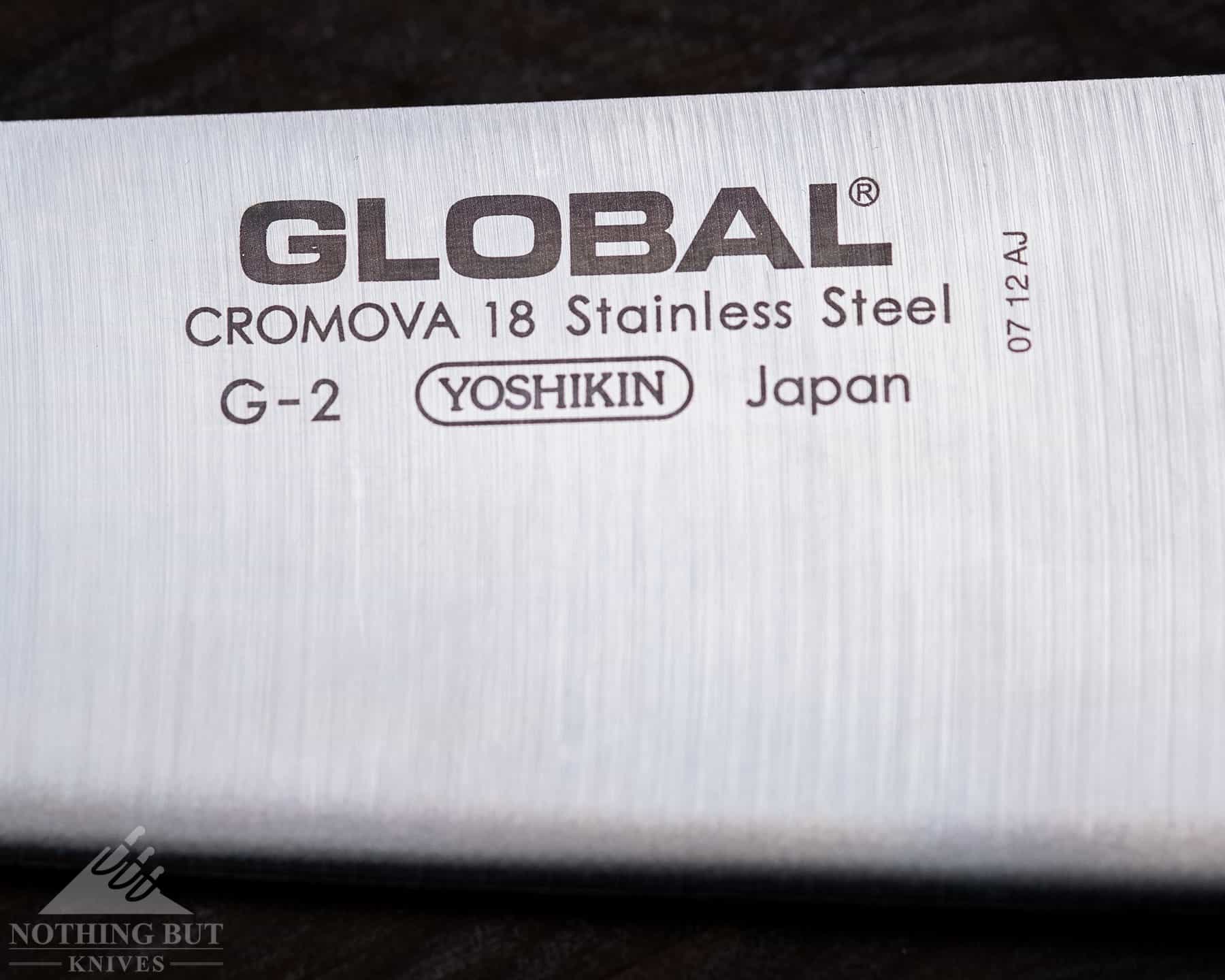
Probably the biggest problem with this knife is that it’s hard to sharpen. Between the convex grind and the oddly soft steel with fairly large carbides, it’s hard to get a refined edge on this thing.
This is where it gets kind of weird in terms of calling the G-2 a high-end knife. Global’s Cromova 18 is comparable to 440B in composition, which was a steel that was okay when the Global G-2 first came out. These days it’s pretty far behind most other steels being used in knives, at least by reputation. I recently reviewed another kitchen knife that had a steel with a similar 440B comparison: 9Cr18MoV. I was pretty impressed with it on that knife, although the edge of the Vosteed Morgan does roll pretty easily.
Meanwhile, the Global G-2 rocked through a whole week of cooking with me and I barely noticed any imperfections in the edge, despite being pretty thin and the steel only being hardened to around 57 HRc.
That’s thanks in large part to the convex grind, which isn’t something you see on production knives very often because it’s a huge pain, even (or maybe especially) when you’re mass producing knives.
Global actually made a somewhat overblown, but mostly informative video of their process which has some pretty good clips of the stages of hand sharpening the knives go through.
The Handle
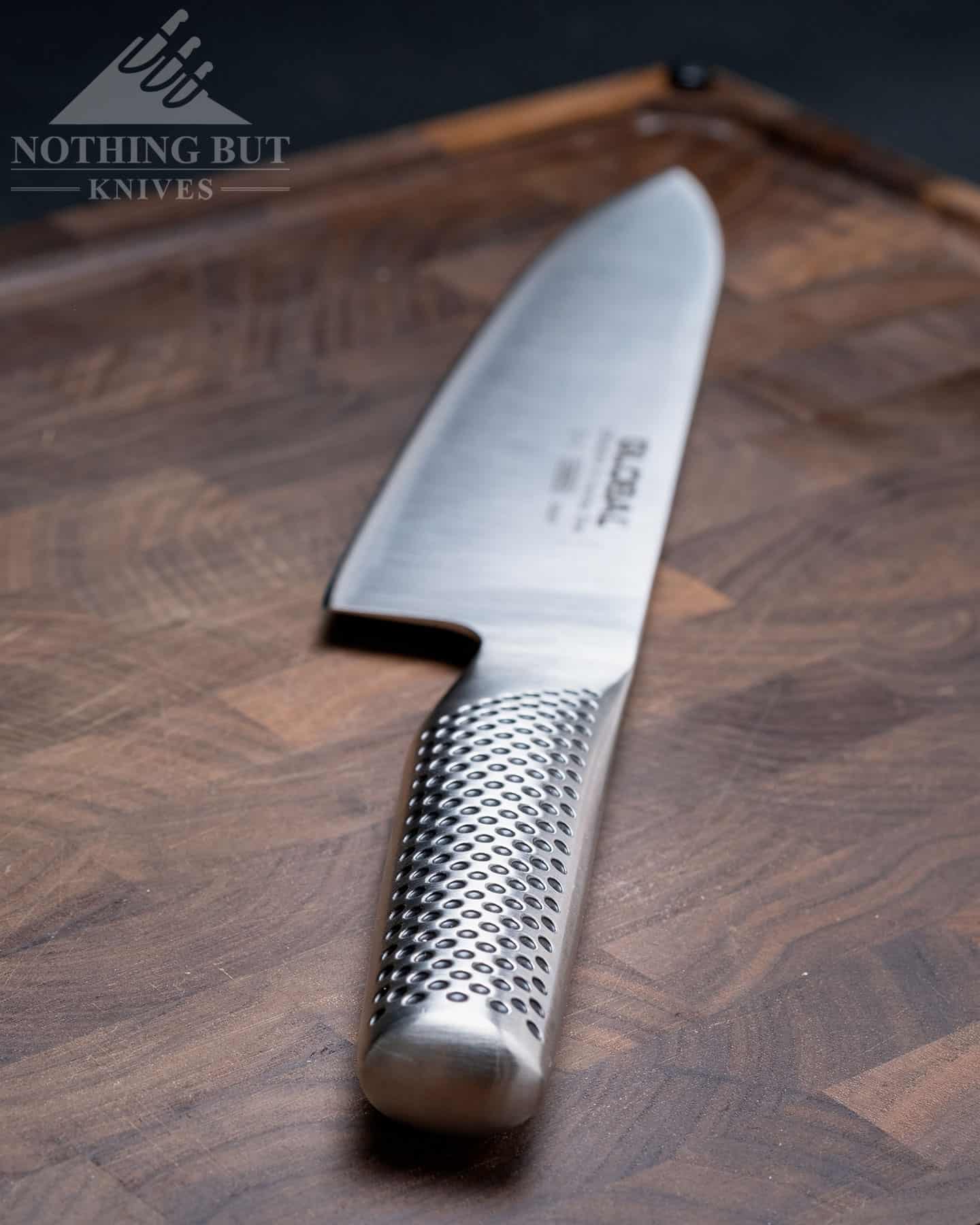
The handle doesn’t look like much, but it is exactly what it needs to be to give my hand the right amount of purchase in a pinch grip.
It’s thin, but the shaping at the top of the handle fits my hands pretty well and gives me a good feeling of leverage and control. I tend to pinch this higher up on the blade to make it easier for my middle finger to slip into that groove when I need it.
It’s just big enough to fill the back of my grip and let me slide farther down on the handle still have plenty to grip when I need to adjust for a longer cut with bigger foods. Global is also meticulous about giving their handles the right amount of weight by making the handles hollow and filling them with sand before capping them off, so this has a really comfortable balance that might be just a little bit handle heavy.
Problems from Steel handles
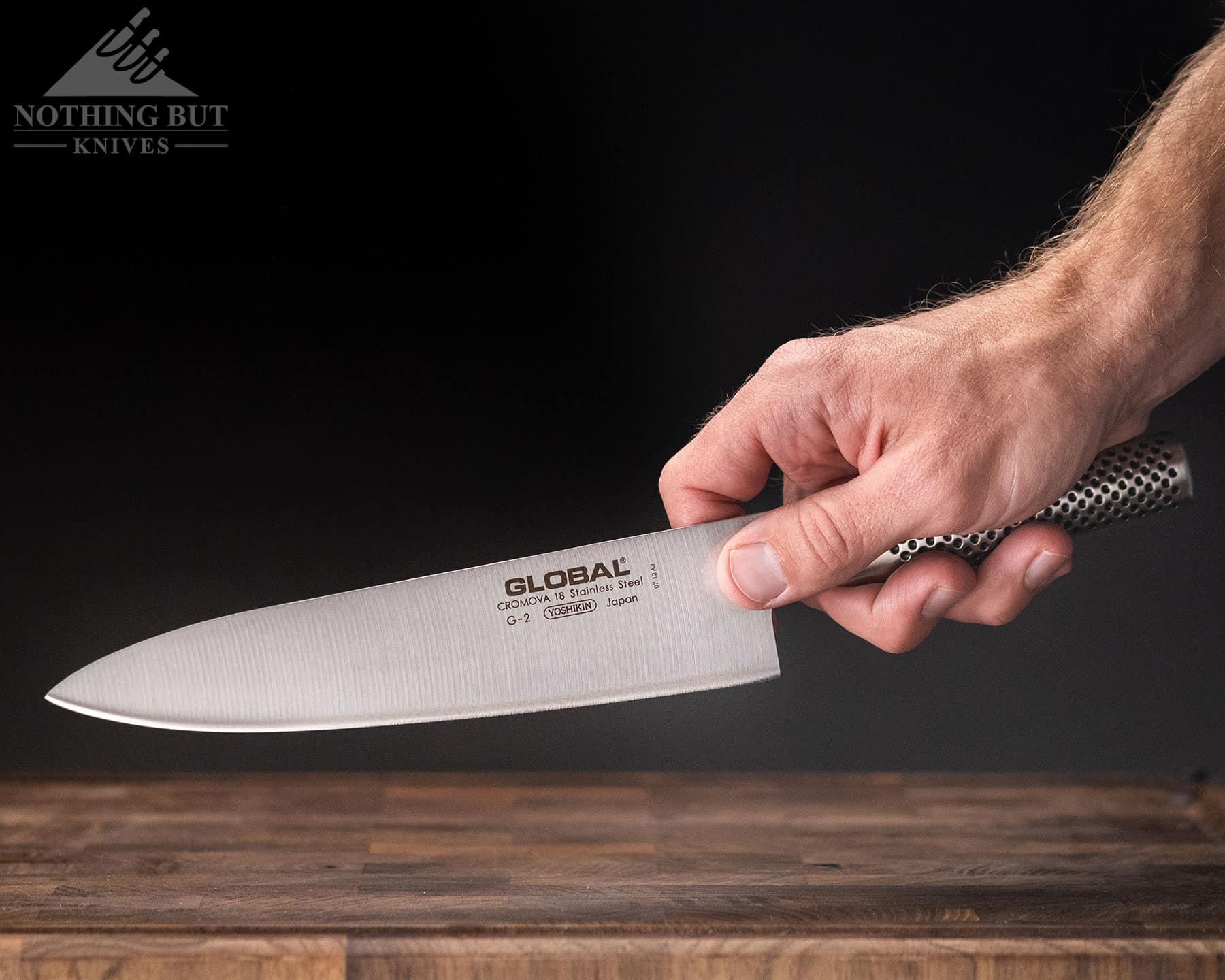
As interesting and nice as the handle is for me, though, I think the quickest turn off for most people unfamiliar with Global is the handle, both because of the way it looks, and the way it can feel over the course of a long work day.
I’ve had an up and down experience with it, starting out not really liking the look, then immediately changing my opinion after I felt the weight and balance. I used this thing happily for a couple weeks.
Then I had one particular cooking session that was just very wet. I was cutting a lot of different foods and constantly rinsing and wiping the knife which made the handle get a little slippery even after I’d wiped it off. The dots in the handle do a good job of adding a little texture, but they also hold onto a tiny bit of water that leaves the handle feeling a little damp.
As a result I started holding the knife harder than I normally would which produced a lot more cramping than a knife this light would normally create.
I’ve also read about experiences from some professional cooks saying Globals tend to give them blisters. I haven’t experienced that personally but I can see how that might happen over the course of a full day of slicing and dicing.
I think the best general take away I can give you here is that the Global G-2 feels really comfortable at first, but it can get trickier the longer you use it. People with smaller hands will probably have an easier time, but big hands and prolonged wetness can make it harder to hold onto over time.
Overall, it’s been really nice for the moderate amount of cooking I do.
Comparison and Alternatives
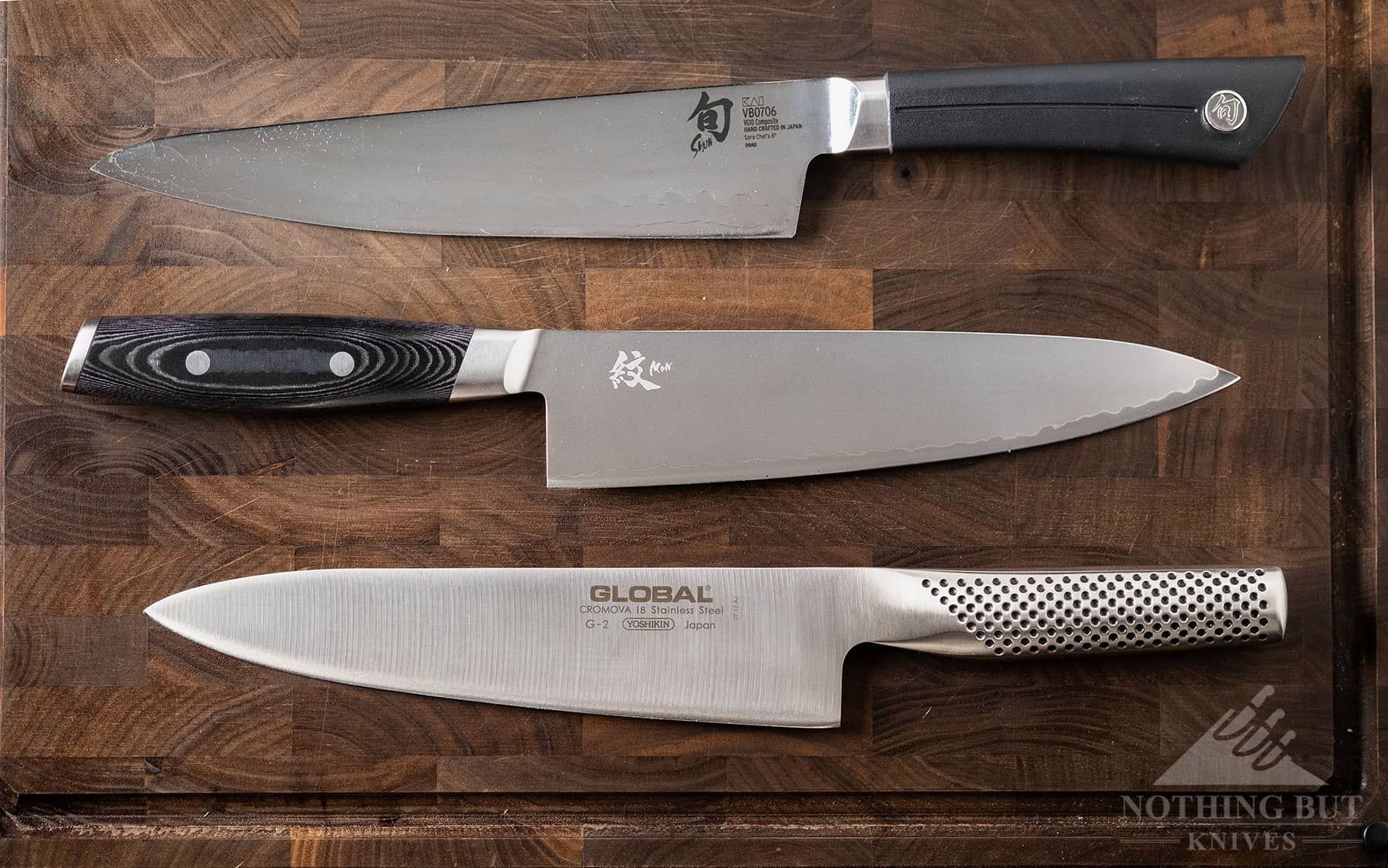
The big sticking issues with the G-2 are the thin steel handles and the convex grind and blade steel that make sharpening a nightmare.
For similar weight, you could pull the trigger on a Shun Sora. It’s a little cheaper, but has a more aggressive bite and will be a little more fragile. The handle material feels more synthetic but it’s also grippier. The Sora might also feel a little heavier toward the handle.
Staying in the upper price ranges, there’s the Miyabi Mizu. It feels more handle heavy, and the follow through on long cuts doesn’t feel as soft, but it bites like a shark. It’s also a lot more handle heavier (and heavier in general).
If you like the Global handle shape but want something a little thicker, I’d probably point you toward the Yaxell Mon. It won’t cut as well without some touch-up sharpening out of the box, but I do find their fatter oval handles to be pretty comfortable.
If you want something that’s both more accessible with steel and price, it’s pretty hard to go wrong with the Tojiro DP. When people say things like “Global knives are too expensive” it’s usually because they’re thinking of Tojiro. These days it’s actually not that much cheaper, but it’s still one of the most financially accessible knives that provide the kind of thin-bladed Japanese knife action that some people seem to crave so badly.
The Global Complication
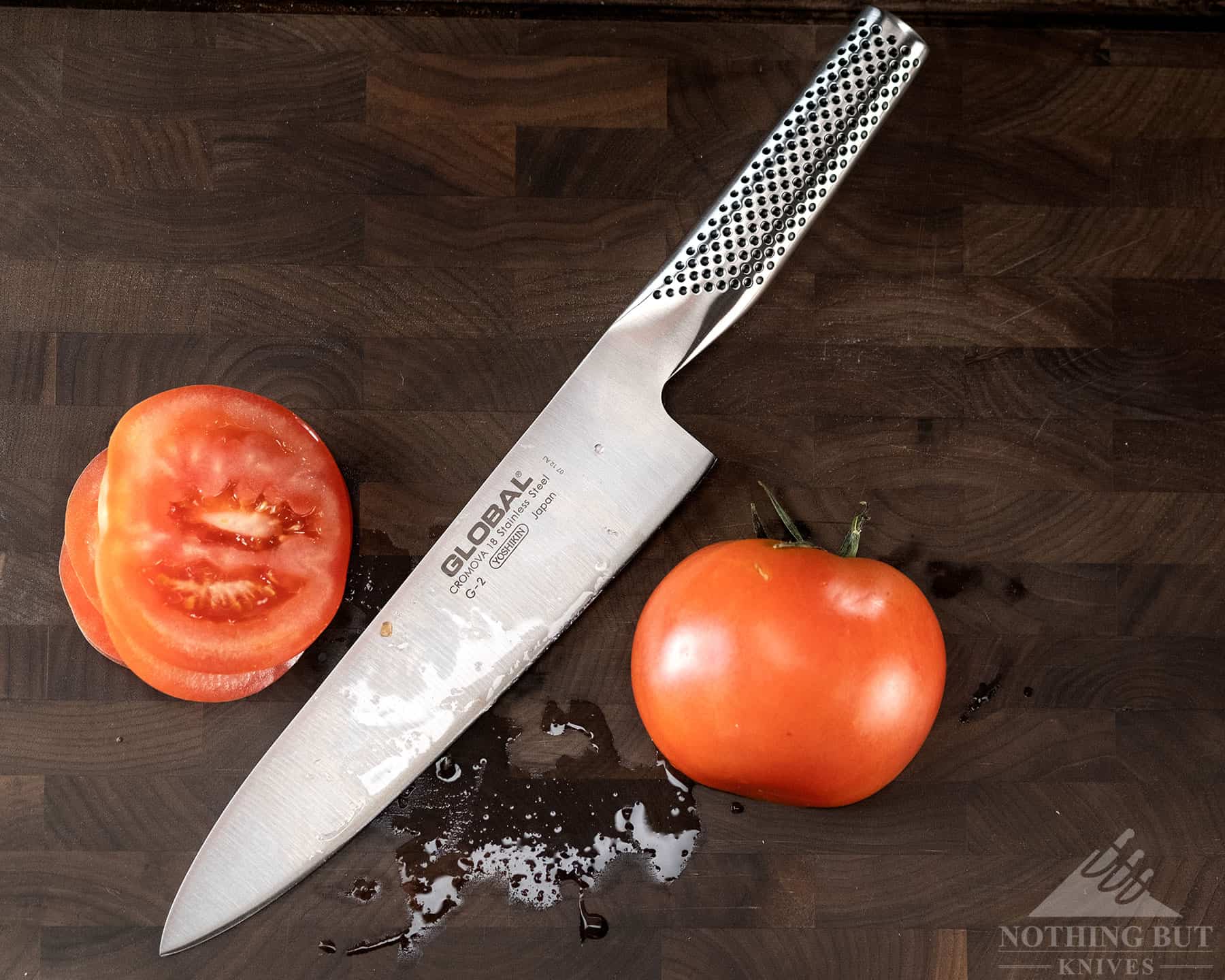
There are a lot of polarizing elements on the Global G-2, starting with the steel handles that are either loved or hated.
People who profess to be “real” Japanese knife enthusiasts tend to look down on Global knives these days because of the thin steel handles, subpar edge retention (compared to other Japanese knives), and the difficulty to sharpen them. It could also be argued that they’re pretty expensive compared to other Japanese knives that cut just as well if not better.
But there are plenty of professional cooks out there who swear by Global.
There’s a reason that half the time you pick up a book about cooking (including but not limited to Anthony Bourdain’s “Kitchen Confidential”, and Chad Ward’s “An Edge in the Kitchen”), it’s likely to recommend the Global G-2 if it talks about knives at all.
Here’s the short of it: Even today, the G-2 cuts better and feels lighter and more comfortable for the money than most production kitchen knives on the market… for some people. But it’s in a hybrid state between Japanese and western cutlery. It has the shape and lightness of a traditional gyuto, but the hardness and edge retention is closer to a western chef’s knife.
They’re usually only hardened to 56 – 58 HRc where a lot of other Japanese knives are 60 – 62 HRc. Top that off with the convex grind in a steel that is notoriously tricky to sharpen, and you might start getting a picture of why some Japanese knife enthusiasts have cooled on Global knives over the years.
It’s worth considering the time the G-2 was released, though. These came out in the 80s before everyone was buying Japanese knives for no other reason than that someone said they had “Japanese steel”. Back then, big heavy western knives were the norm, so people were used to being able to treat their kitchen knives like battering rams. Global couldn’t just put out a super thin, and equally super fragile knife in the western market and expect it to survive. So they made it softer then finished it with a convex grind that doesn’t really bite.
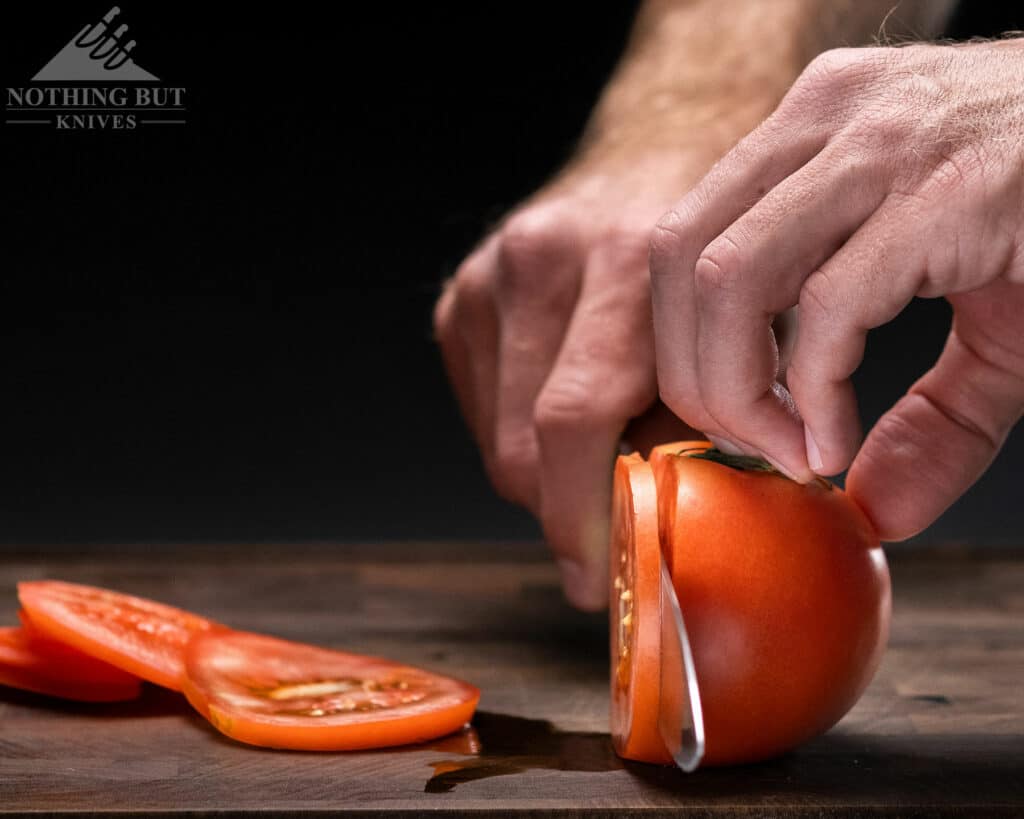
It’s no wonder that people who are used to the 12° flat grinds of their Takemuras don’t like the Global G-2. It’s a completely different feeling. Global isn’t really making their knives for enthusiasts or traditionalists. They’re making them for people who have to cook a lot.
So it will dull quicker than a Shun (for example, although enthusiasts are even harsher on that company), but won’t chip as easily during use. Meanwhile, if you compare it to the Western kitchen knives that people were used to in the 80’s, the Global G-2 cuts a hell of lot cleaner and holds a much better edge just by virtue of being thinner.
This is my first recommendation to anyone who wants to get into Japanese knives or just wants something that cuts very cleanly without being too frail.
It’s also come down in price over the years. Not quite enough to be considered budget, and certainly not enough to fix any complaints that it’s more expensive than more modestly priced but high functioning knives, but a lot better than it was.
But It’s not a Single Piece of Steel
This isn’t incredibly important to clear up, because it doesn’t make that much of a difference, but retailers keep describing Global knives as being “made from a single piece of steel”, which isn’t remotely true. It’s made from three pieces:
The blade, the handle, and the handle cap.
Here’s the process. First they weld the blade to the hollow handle, then fill the handle with sand to balance it out, then they weld the cap to the butt of the handle. After that it’s all polishing out the weld lines and sharpening.
Before you get all up in arms about this process making the knife weaker, let me assure you that as far as Japanese kitchen knives are concerned, Global knives are plenty strong. I might be worried about this process if they were making bushcraft knives, but welded blades work just fine so long as I’m just cutting food.
Its a Great Lightweight Option
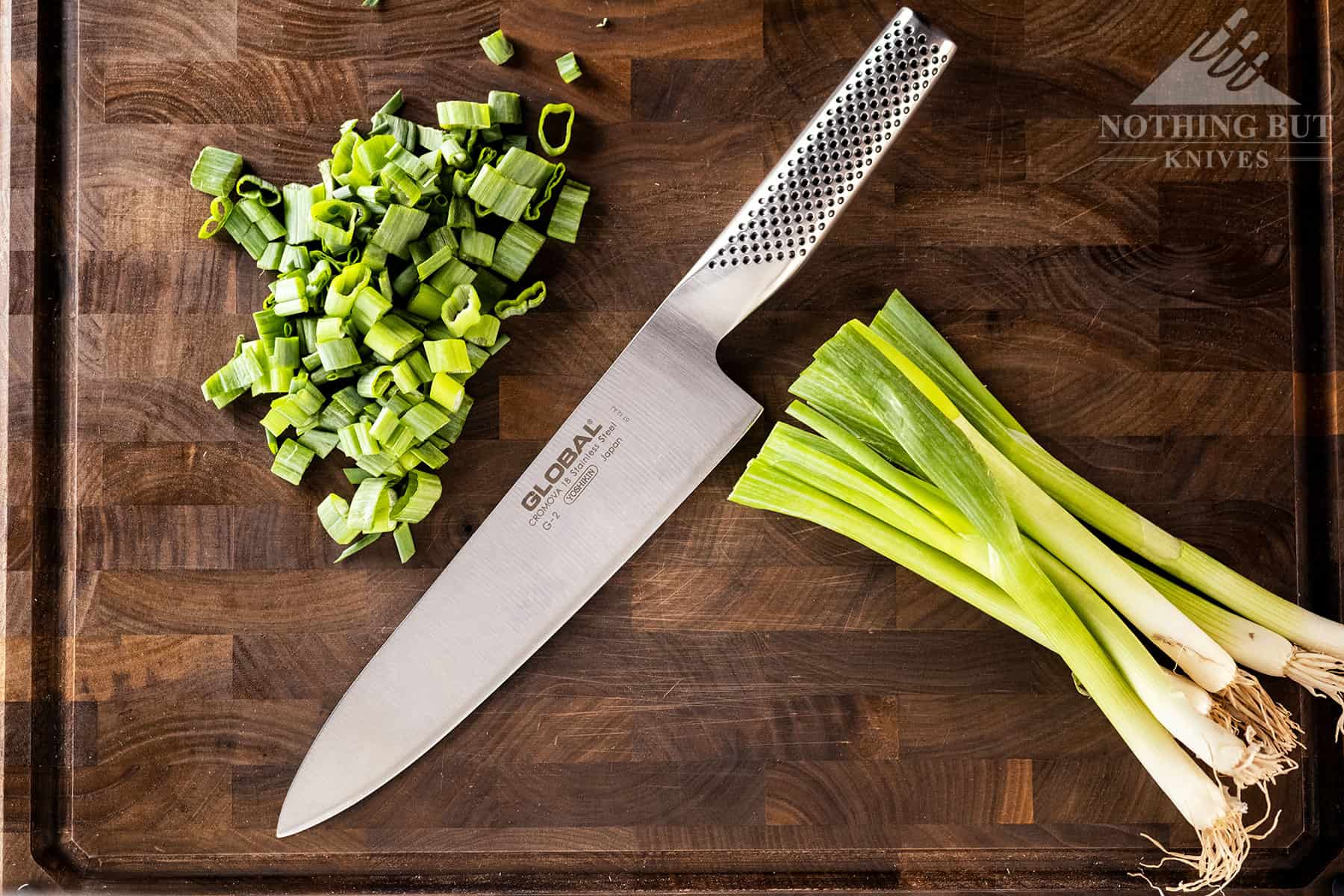
The knife performs well enough and feels unique enough to still be very relevant. There just aren’t other quality knives out there that have handles like this and a convex grind. If those are the kinds of things you like, you’ll like this knife. Otherwise, it really will be an overpriced piece of metal taking up room in your knife block.
There are a couple of ways to look at this knife: It’s a good transition knife for moving from thicker western knives to thinner, more frail Japanese knives, or it’s a happy medium between the two for someone who doesn’t particularly like either style.
For home use, this will probably last a long time. But this is more of a starter for anyone who will be using it several hours a day in a professional kitchen. If it’s being taken care of and sharpened regularly it should be good for a few years, but I honestly wouldn’t recommend it for a cook or chef who’s gotten used to either Western or Japanese knives, because the in-between state of the G-2 seems to throw those people off.
For the moderate home cook, though, this is a pretty low-risk blade that you could very well end up passing on to your kids.

I really appreciate these knife reviews! Buying anything these days requires so much research. You did an in-depth review of the Global G-2 8″ Chef Knife, which I heard was Anthony Bourdain’s favorite chef knife. Without trying out the knives myself, how is one to know which one to buy. Your reviews fill that knowledge gap nicely.
Being a female, and having finer hands, I cannot use the bulky handles or very long blades efficiently. I think this knife will fit my needs and budget, although I have some trepidation about the convex blade edge for sharpness and sharpening. Oh well, nothing is perfect! Thank you for your wonderful reviews, very grateful to have them! Please do not spam me or sell email.
I’m guessing the Global was Bourdain’s favorite knife up until he got his Kramer, but it definitely seems to be a consistently loved knife where professionals and finer-handed people are concerned.
The convex edge is definitely tricky at first, but it’s actually easy to touch up on a strop. If you touch it up on one of those every now and then, you’ll barely need to put the knife to a stone, and when you do, most professional sharpeners don’t charge much.
Anyway, I’m glad we could help. Thanks for reading, and don’t worry about your email. We do not have the energy for spamming. We barely even remember to send out our newsletter.